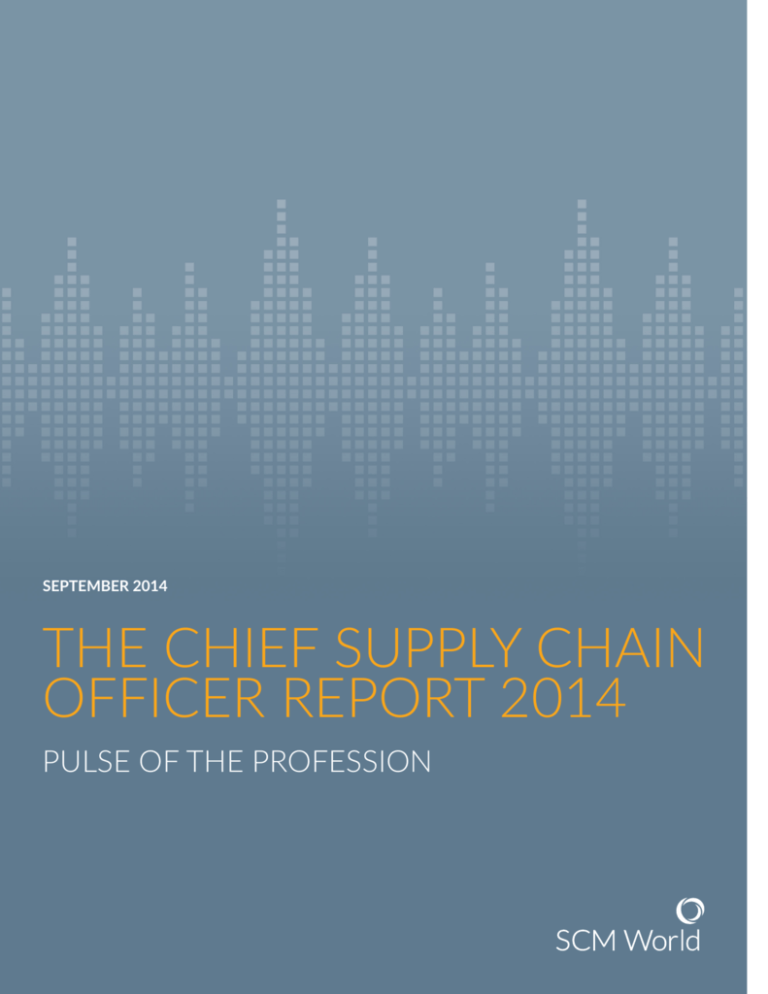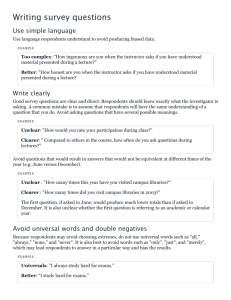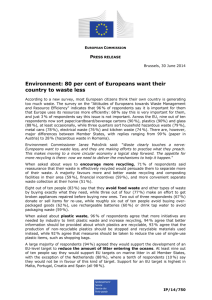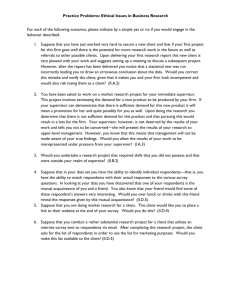
SEPTEMBER 2014
THE CHIEF SUPPLY CHAIN
OFFICER REPORT 2014
PULSE OF THE PROFESSION
Report authors:
Kevin O’Marah
Geraint John
Barry Blake
This document is the result of primary research performed by SCM World. SCM World’s methodologies provide for
© 2014 SCM World. All rights reserved.
CONTENTS
FOREWORD .......................................................................................................4
INTRODUCTION ...............................................................................................5
.....................................................................................8
................................................................................ 10
1: CUSTOMER CENTRICITY ........................................................................ 12
............................................... 14
.................................................................. 16
.......................................................... 18
................................................................. 20
.......................................... 22
...................................................... 24
................................................................................ 26
........................................................................................ 28
........................................................... 30
A global supply chain
focused on growth,
agility and sustainability.
It’s part of our DNA.
FOREWORD
Hans van Alebeek
Technology
Nike
control panel creates tremendous architectural challenges for the supply chain. Companies
INTRODUCTION
In 2014 we
modules that comprise the SCM World
analyses of past years.
with 1,068
completed
across all
THE POPULATION
collected represents the largest and most
on the topic of supply chain management
use it as a common touchstone for all of our
industries and
geographies.
of all respondents by industry can be seen in
Figure 1.
Respondents by industry sector
th
er
en
D
ef
6
O
g
in
in
M
&
&
Ae
ro
sp
ac
e
re
ul
tu
ric
Ag
2
ce
2
pa
Ap
&
br
ic
Fa
ed
ia
&
ad
Te
em
lc
ic
il
ta
2
re
l
3
o
3
Ac
ot
m
Re
iv
n
tio
4
M
&
s
ic
st
gi
Lo
to
tri
D
is
&
es
iti
til
Au
bu
s
En
ic
al
he
4
e
5
er
gy
6
m
ar
m
Ph
&
C
U
l
ria
du
st
ca
lth
ea
H
6
a
8
re
&
Be
In
h
ec
i-T
H
8
od
Fo
C
9
ge
16
PG
16
ve
ra
1
% of respondents
n=1,068
Respondents by geography
2
as possible geographically. Nearly half of our
Europe, Middle East & Africa
1
Asia & Australia
36
another 14% in Asia.
49
North & South America
Rest of the World
The respondent pool also comprises
% of respondents
n=1,068
14
Respondents by job level
3
SVP/EVP/Board Level
11
16
VP/Director
Manager/Head
29
Other
% of respondents
n=1,068
44
of responsibility.
4
Respondents by annual sales
<$1bn
11
22
$1bn-$5bn
$5bn-$10bn
23
$10bn-$25bn
21
$25bn plus
11
Undisclosed
12
% of respondents
n=1,068
sales. Almost half have revenue of more than
5
Respondents by job function
Supply Chain
14
Purchasing/Procurement
5
Logistics/Transport & Distribution
5
48
8
Operations
Manufacturing/Production
9
11
General Management
Other
% of respondents
n=1,068
DISRUPTIVE TECHNOLOGIES
mechanical enablement and pure content
for demand sensing and remote control of
MOST ATTRACTIVE MARKETS
FOR GROWTH
6
Disruptive technologies for supply chain
Big data analytics
64
31
5
Digital supply chain
49
45
6
Internet of things
45
42
13
Cloud computing
33
53
14
Advanced robotics
27
40
33
5
3D printing
20
42
38
6
Drone/self-guided vehicles
11
38
51
Sharing economy (e.g., Uber, Airbnb, Instacart)
8
to the top of our list.
53
Disruptive and important
increasingly need to be tuned to serve
39
Interesting, but unclear usefulness
Irrelevant
% of respondents
n=1,057
Top countries from a
the most risky in which to operate. China is by a wide margin the most
Country growth opportunities versus risks
Selected countries in top 50 for growth and risk
Germany
UK
Japan
Turkey
France
GROWTH OPPORTUNITY
Indonesia
Australia
Mexico
Russia
Nigeria
Nigeria
South Africa
United Arab Emirates
Malaysia
Singapore
India
USA
Canada
South
Korea
China
Brazil
HIGH
7
Saudi Arabia
Vietnam
Poland
Angola
LOW
Iran
Egypt
LOW
.
Ukraine
Pakistan
.
..
Venezuela
OPERATING RISK
Note: Respondents were asked to rank their top 3 countries for growth and risk. The size of the bubbles represent
the scale of the growth opportunity, calculated by weighting the scores.
n=936
HIGH
SUMMARY
delegate strategic understanding of supply
the profession. Its main message is that supply
chain strategists need to raise their sights from
Uncertainty has long been supply chain’s
throughout value chains.
EMBRACING UNCERTAINTY
It may once have been sensible to
of process dominance in the supply chain
capacity and technology that customers
2014 may be the year that marks the end
in supply chain.
40% of all respondents say they use social
Looking ahead, those that are able to
true cost to serve
demand noise.
business value are also increasingly
Uncertainty has long been supply
chain’s enemy. Business leaders hoping
to succeed in this new era must learn to
assert that supply chain is understood by
make it a friend.
product management in the success of the
jointly developing intellectual property are
to all people.
deepening their roots.
point in the data is the doubling since 2011
are able to master emerging tools for data
of their products. The depth of mechanical
chain is clearly increasing.
chain professionals masters the deeply
1
CUSTOMER
CENTRICITY
on customer centricity.
The importance of customer service also
senior business management sees supply
constraints presented at the point of sale as
to sales and product management rather
than simply a cost centre believe that
customer service is paramount. Supply chain
to appreciate the urgency of customer service
challenges of 2014.
These same supply chains that are considered
By a factor of nearly 2:1 those who state
that their CEOs consider them equal
partners to sales and product management
that
centricity at the highest level is not just about
9
Value of enhanced customer service/loyalty
Supply chain is equal partner
53
47
Supply chain is enabler
37
63
Supply chain is cost centre
36
64
Supply chain is service function
visibility to ready inventory and true cost
31
to serve it could easily destroy margins.
69
Very high value
Other
% of respondents
n=1,061
commitments at the point of sale may be the
10
Skill is ‘essential’ for supply chain
customer centric.
Customer management
8
Customer service integration
63
53
Governance
Value created through a high-performing supply chain
49
43
Logistics & Distribution
61
34
Retail
56
37
Sales
37
26
Chemicals
50
34
Hi-Tech
39
Industrial
45
39
CPG
41
40
84
86
Foundational supply chain
46
Planning
Delivery/logistics
79
75
Sourcing
73
69
Manufacturing
Healthcare & Pharma
33
Very high value
60
47
43
High value
% of respondents
n=1,022
Equal partners
Other
% of respondents
n=1,021
2
OMNICHANNEL
most certainly become commonplace.
pointed to radical change.
forecast to top $370 billion by 2017. Although
rated the second most important driver of
45%. This may indicate simply that progress
has been made and that some have already
e-commerce represented 8% of US and
15%
are forecast to top $370 billion by 2017.
supply chain speed and agility are more
13
11
% of respondents saying their supply chain is…
% of respondents saying their supply chain is supporting…
10
23
Much larger SKU
assortments
capabilities
Some SKU expansion
Relying on e-commerce retailers for
Little or no change in
SKU assortments
Smaller SKU
assortments
30
Seeing little or no change to existing
45
38
37
17
n=1,034
12
% of respondents saying their supply chain is building…
Larger, more centralised
distribution centres
33
Smaller, more local
distribution centres
n=1,037
14
Fabric & Apparel
The same type of
distribution centres
46
5
95
Media & Telco
6
73
21
Retail
5
70
25
Logistics & Distribution
21
18
66
n=1,035
16
Industrial
50
8
48
13
42
Hi-Tech
39
CPG
28
42
30
Automotive
38
13
49
15
48
Chemicals
37
Food & Beverage
28
35
37
Healthcare & Pharma
34
15
capabilities
Relying on e-commerce retailers for
Seeing little or no change to existing
51
% of respondents
n=857
3
1
Our latest CSCO study data not only
respondents are either concerned or very
other retailers and manufacturers. The small
When our 2014 CSCO data is cut by industry
that they plan to increase investments in
is that the sectors seeing the most change are
sector average.
not part of these investment plans. Over half
1
The Smart DC: Delivering Value Through State-of-the-Art Distribution & Logistics, SCM World, March 2014.
not changed the way they build
suggests
15 Sector differences on DC building plans
Fabric & Apparel
52
24
24
Logistics & Distribution
45
22
33
Media & Telco
38
27
35
Retail
27
25
48
Industrial
33
26
41
Hi-Tech
37
19
44
Food & Beverage
33
22
45
CPG
32
22
46
Healthcare & Pharma
31
20
49
Chemicals
25
17
58
Automotive
23
18
59
Larger
Smaller
Same
% of respondents
n=853
4
manufacturing strategies in the CSCO survey. The data suggests that
manufacturing topped supply chain strategists’
amount of outsourced manufacturing. The
support this.
year. In our report Manufacturing Footprints:
factories or retailers closer to customers.
been successful in businesses ranging from
52%
of manufacturing
companies expect to be highly
a supply chain strategy that enables greater
customer needs.
of the value of their products comes from
outsourced.
product value.
16
We will be a highly verticalised business,
with most parts of production in-house
25
In-house production will be limited to
modular platforms and critical parts,
on demand by a network of third-party
factories or retailers closer to customers
52
Production will be mainly outsourced;
we will essentially design, distribute and
service our products
23
% of respondents
n=989
18
Chemicals
77
17
6
Food & Beverage
77
13
10
CPG
than in years past. The challenge this presents
68
13
19
Industrial
52
26
22
Automotive
46
49
5
Hi-Tech
32
17
Value from standard platforms/components shared across
multiple products
22
46
Fabric & Apparel
13
23
64
More than 70%
25
We will be a highly verticalised business, with most parts of
production in-house
From 30% to 70%
50
In-house production will be limited to modular platforms and
Less than 30%
a network of third-party factories or retailers closer to customers
25
% of respondents
n=1,017
Production will be mainly outsourced; we will essentially design,
distribute and service our products
% of respondents
n=630
5
design phase.
Our CSCO data indicates that about a third of
Design
inclusive of inputs not only from engineers
and manufacturing. Most companies are
integrated it should be.
less numerous than the survey data suggests.
not feel fully integrated in the process.
19 Organisational structures for NPDL
PURE SILO
ORGANISATION
7%
23%
Product design and engineering/
R&D functions are isolated from both
manufacturing/supply chain and
sales & marketing
Sourcing, logistics,
manufacturing
LINKED
ORGANISATION
Marketing,
sales, service
Product design and engineering/
R&D functions are loosely linked to
manufacturing/supply chain and
sales & marketing. Lessons learned
in operations, product development
and sales are captured, but not
exploited across the functions
Design, R&D,
engineering
SEMI-INTEGRATED
ORGANISATION
38%
Product design and engineering/
R&D functions are partially linked to
manufacturing/supply chain but only
loosely tied to customer need via
sales & marketing. Lessons learned
in sales & marketing (e.g., product
hit rate) are captured, but not fully
exploited by product design and
engineering/R&D functions
INTEGRATED
ORGANISATION
32%
Sales & marketing, manufacturing/
supply chain and product design
and engineering/R&D functions are
equal partners in an orchestrated
new product development and
launch process. Lessons learned
in operations, innovation and the
market inform and support future
generations of product
% of respondents
n=1,092
Where CEOs see supply chain as
equally important to sales or product
around
companies today is not yet considered
for digital delivery late in the manufacturing
the direct involvement of top management.
21
Supply chain is understood as an equally important part of business success as
sales & marketing or R&D/product development
45
16
35
4
Supply chain is an enabler of product or sales-driven business strategies
get integrated around a streamlined NPDL
22
28
43
7
Supply chain is understood primarily as a cost centre that affects margins
13
39
34
14
Supply chain is strictly seen as a function meant to service the business
23
10
40
27
Integrated organisation
Semi-integrated organisation
Linked organisation
Pure silo organisation
% of respondents
n=1,029
20
Weighted average 1-4, where 1=pure silo, 4=integrated
Customer facing
Sales & marketing
FUNCTIONS
PURE SILO
ORGANISATION
LINKED
ORGANISATION
SEMI-INTEGRATED
ORGANISATION
General management
Engineering/R&D
Internal facing
Manufacturing/Operations
Supply Chain/Logistics
INTEGRATED
ORGANISATION
Purchasing/Procurement
Supply facing
1
2
3
4
% of respondents
n=990
6
see in manufacturing and product design.
across industry to commit not only to ever
nesses are on their suppliers.
of survey respondents saying that strong sup
perhaps not surprisingly given their short
Our analysis of the data indicates that strategic
supplier engagement has the biggest impact on
defence and apparel are the sectors that care
64% of respondents say
that priority access to scarce raw
And although access to a supplier’s best talent
may be last on the supplier engagement ben
Our analysis of the data
indicates that strategic
has
the biggest impact on the
22
% of respondents saying ‘extremely relevant’
Supplier giving you priority in
times of tight supply/capacity
64
of supply chain
64
Collaboration on quality
improvements
54
Faster problem solving/time to
market
54
Supplier giving you innovations/
ideas ahead of competitors
46
Joint risk mitigation strategies
36
Co-development of new
products/services
35
Collaboration on new customer
propositions
30
Access to supplier’s best talent
internal standing.
29
n=886
23
Importance to competitive advantage
Very important
27
69
3 1
Important
42
44
10
4
Neither important nor unimportant
28
53
12
7
Somewhat unimportant
14
51
29
6
Not at all important
43
28
29
Supply chain is equal partner
Supply chain is enabler
Supply chain is cost centre
Supply chain is service function
% of respondents
n=1,050
7
management and general business leadership.
long. Most companies have strong internal
management processes that channel and
maturity must centre on the enablement of
company’s business strategy to focus on supply
24
25
% of respondents saying ‘very important’ or ‘important’
% of respondents saying ‘very’ or ‘somewhat’ concerned
Operating cost reduction
96
Chemicals
86
Agility and speed
90
CPG
85
Increasing revenue
86
Hi-Tech
84
Strategic supplier
engagement
84
Industrial
79
Differentiated customer
service capabilities
84
Retail
79
Long-term equity
improvement
74
Healthcare & Pharma
78
Logistics & Distribution
74
n=1,061
n=754
More than 80% of respondents in
70% in industrial, healthcare
response to changes in demand. The fact also
at the top in importance indicates that simple
Considering also the importance of customer
or somewhat concerned about
.
26
Source of real-time customer
feedback
41
Inform product enhancement/
innovation priorities
31
Give visibility of social/
environmental/labour practices
30
Provide advance warning of
potential supply disruptions
23
Improved communication with
trading partners
19
Improved demand sensing and
forecasting
19
No effect
33
% of respondents
n=1,048
8
A recent SCM World report2
percentage points.
27 Where risk leaders are ahead of the pack
Using risk mapping to identify
exposure to potential risks
60
48
Dual or multi-sourcing is
used ‘very effectively’ for risk
mitigation
52
36
Active inventory tracking is
used ‘very effectively’ for risk
mitigation
51
40
Using real-time data analytics
to identify exposure to potential
risks
47
30
Joint risk mitigation with strategic
suppliers ‘extremely relevant’ to
competitive advantage
45
24
Visibility of potential risks at
tier-2 suppliers is ‘very good’
or ‘good’
41
31
Using social media monitoring
to identify exposure to potential
risks
23
18
Visibility of potential risks at
tier-3+ suppliers is ‘very good’
or ‘good’
21
13
Risk leaders*
Others^
% of respondents
n=1,053
* Those who say that leveraging opportunities from supply disruptions gives ‘high’ or
‘very high’ value
^ Those who say leveraging opportunities from supply disruptions gives ‘moderate’, ‘little’
or ‘no’ value
2
Innovative Approaches to Supply Chain Risk, SCM World, July 2014.
of users report very high value and 44%
al
ic
lit
in
st
ab
ilit
di
y
su sas
t
pp e
D
lie r af
at
r f fe
a
ac ct
se
ilit ing
cu
ie
rit
s
y/
IT
in
ci
de
Sh
nt
ip
s
pi
ng
di /lo
sr gi
Br
up st
ea
tio ics
ch
ns
o
pr f i
op nte
Sa
er lle
fe
ty c
ty
rig tua
/q
ht l
ua
s
lit
y
in
Le
c
ga
id
en
l/r
eg
ts
O
ul
th
at
er
or
y
in
is
ci
su
de
es
nt
s
at
Su
s
m pp
fa upp
at ly
er sh cilit lier
i
ia o
ls rta es
/c g
om e
po of
ne ke
nt y
s
al
ur
N
at
po
eo
G
20
8
6
6
6
4
4
4
3
-1
-2
pr
ic
ilu
re
of
l
al
iti
c
cr
e
n
vo
to cia
la
m lf
til
er ai
ity
lu
re
of
cr
iti
ca
cu
s
na
Fi
ity
od
m
C
om
F
su inan
pp c
lie ial
r fa
28 Key supply chain risks: risers and fallers
% point change in respondents ‘very’ or ‘somewhat’ concerned in 2014 vs 2013
-4
n=1,040
9
2014 is the steady rise of cost savings as a
the leading reason for such investments this
far is cost savings.
to include the high value placed on brand
companies for green or socially responsible
don’t buy from sustainable supply chains as
29
an
d
im
tin
ui
-11
Br
co
n
ly
pp
In
cr
8
ag
e
11
ty
gu
la
tio
n
19
Re
PR
26
Su
Re
du
ce
co
st
s
61
ea
s
e
sa
le
s
% change, 2011-14
2014 n=975
for good behaviour on the upside.
One of the most
30
Internal operations
45
34
in 2014 is the steady
rise of cost savings
42
49
Key suppliers
24
21
48
46
Extended supplier network
10
10
33
35
Whole value chain
14
10
38
% of respondents
2014 n=955
37
2014 Activities fully implemented
2014 Currently implementing activities
2013 Activities fully implemented
2013 Currently implementing activities
31
Internal operations
visibility at the point of sale could include
51
47
46
38
Key suppliers
35
25
23
9
by choosing one product over another may
environmental impact.
Extended supplier network
16
9
9
4
Whole value chain
17
14
13
6
Hi-Tech
Consumer Goods & Retail
Industrial
Healthcare & Pharmaceutical
% of respondents
n=955
10
TRANSFORMATION
In companies that have yet to connect supply
Digging into the root causes reveals that
much of the pain comes at the front end of the
from the broader supply chain strategy of
has to be synced into the broader strategic plan
the pressure has ramped up steadily. Despite
rate in 2011 and up notably over last year.
43%
has become harder in the past two years
33 Knowledge worker challenges
% of respondents saying ‘extremely challenging’
30%
technology enablement.
25%
20%
15%
10%
5%
2014 n=1,023
0%
2011
2012
2013
2014
Career progression
Retaining
Developing
Finding
Hiring
Measuring
34
32
Planning
85
1
14
Delivery/logistics
21
1
23
1
78
Performance management
76
Change management
24
74
2
Sourcing
71
15
22
2011
19
37
2013
14
43
3
26
Customer management
30
58
2014
12
Manufacturing
54
35
11
Technology enablement
Easier
% of respondents
2014 n=1,015
6
42
52
New product development & launch
51
12
37
Governance
45
46
9
Sales
38
31
31
Post-sales support
46
26
Essential
Nice to have
Not part of supply chain
28
% of respondents
n=1,020
SCM WORLD
scmworld.com
Geraint John
geraint.john@scmworld.com
London SE1 9RA
scmworld.com








